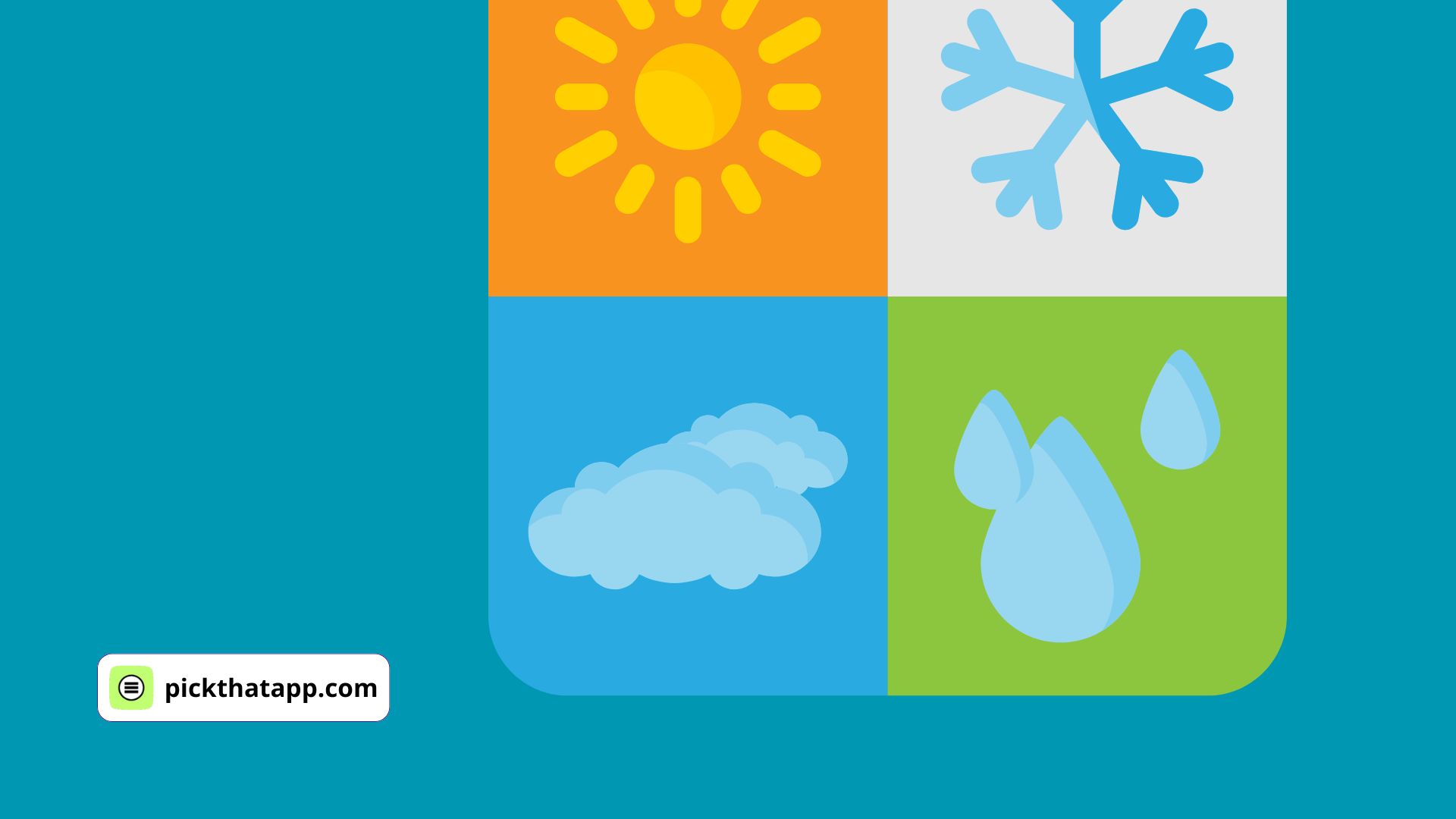When it comes to staying ahead of unpredictable weather patterns, the right iOS weather app can be a game-changer. But not everyone wants just a daily high and low temperature: some want AI-based humor, hyperlocal rain alerts, or advanced radar maps.
The good news is that 2025 offers a vibrant array of weather tools designed to match your specific needs and preferences. In the following paragraphs, we’ll explore the best iOS weather apps available this year, unearthing their strengths and highlighting who each one is best suited for.
By the end, you’ll have a clear map to select the right combination of features that resonates with you.
Why Weather Apps Matter for iOS Users
Selecting the right weather app might seem mundane, but this seemingly small decision can make or break your day, especially if you have a passion for planning events, are an avid hiker, or simply don’t want to get caught in a midday downpour. With iOS devices, you enjoy unique advantages that merge smoothly with Apple’s ecosystem: from lock screen widgets to battery-efficient push notifications. Let’s see why these considerations matter more than ever.
Accuracy and Personalization
One of the biggest reasons to look beyond the default app is the sheer degree of personalization now possible. In 2025, weather apps leverage powerful AI and machine learning models to deliver hyperlocal data. This means forecasts drilled down not just to the city, but sometimes to your immediate street or neighborhood. Gone are the days of one-size-fits-all predictions. Today’s software knows the environment around you, interprets data from multiple radar sites, and refines predictions with every cloud that passes overhead.
For the extra-curious, many apps even allow you to select which forecast model you trust the most, be it ECMWF for global coverage or a local model that excels in your region. This multi-layered approach to accuracy ensures that you know, practically to the minute, when you should bring an umbrella.
Key iOS Advantages
Beyond the raw data, it’s the seamless iOS integration that propels these apps beyond ordinary solutions. Take lock screen widgets, for instance. If you frequently glance at your phone during a busy workday, a quick look can inform you of potential rain or an incoming heat wave. Apple’s ecosystem also excels in preserving battery life by optimizing background refresh. You can keep location services on without severely draining your phone, allowing real-time adjustments to your forecast whenever you’re on the go.
Tip: Many iOS weather apps support push notifications for severe weather alerts or even lightning strikes within a specified radius. By calibrating these alerts, you ensure you’re never blindsided by a sudden thunderstorm, while avoiding trivial pings every hour.
Top Features to Look For in an iOS Weather App
Choosing the right weather app can be easier if you break down the elements that matter most, data sources, user experience, and specialized features. Let’s dissect these components before we move on to the reviews.
Data Sources and Forecast Models
Think of forecast models like different lenses through which you view the weather. Some are broader and capture a global perspective, while others specialize in microclimates and short-term precipitation patterns. Typically, apps that rely on a single model either excel in certain regions or suffer in areas the model isn’t optimized for. If you want the freedom to compare and choose, look for apps that allow model switching (e.g., ECMWF, GFS, NAM, ICON, etc.). The more transparent an app is about data sources, the more control you have over your forecast’s accuracy.
Additionally, local weather stations and crowdsourced data can fill in gaps that larger models sometimes miss. Some apps incorporate user-reported conditions, so if a neighbor reports sudden hail, the app can refine its data for your street. Over time, these hyperlocal updates can lead to near-real-time condition changes, which is a boon for gardeners, outdoor enthusiasts, and those living in rapidly changing microclimates.
User Experience and Interface Design
Data is critical, but how that data is presented can make or break an app. An intuitive interface ensures you see what matters most at a glance. If an app overcomplicates its design, you might get lost in endless tabs or struggle to find the daily high and low. Conversely, an overly simplistic layout might hide advanced data behind paywalls or multi-step navigations.
For instance, some apps show interactive maps brimming with color-coded wind speeds, precipitation levels, and even humidity gradients. Others lean toward minimalist layouts that keep text to the forefront. Which style you prefer depends on your comfort level with reading visual data. If you’re a more intuitive learner, an animated radar might help you plan your weekend better than a text-based forecast.
Unique or Advanced Capabilities
Do you need warnings for the next tropical storm or the earliest sign of a tornado? Or perhaps you’re a frequent traveler interested in temperature and precipitation along a 600-mile route. Specialized features like hurricane trackers, lightning radius notifications, and road trip weather planning can be game-changers.
- Hurricane and tropical storm alerts: Crucial for coastal or island residents.
- Lightning trackers: Great for outdoor sports, golf courses, or storm photographers.
- Air quality and pollen data: Indispensable for asthma or allergy sufferers.
- Travel route forecasts: Perfect for planning a weekend getaway without weather surprises.
Apps offering such specialized features also tend to have robust free tiers, although certain advanced options might sit behind a subscription paywall. Decide what’s essential for your life, and balance it with your willingness to pay a monthly or yearly fee.
A Detailed Look at the Best iOS Weather Apps
In the sections below, we’ll examine each standout app, exploring how it caters to specific user preferences. Remember that these apps often complement each other, so don’t hesitate to use two or more if you appreciate varied perspectives on the same forecast.
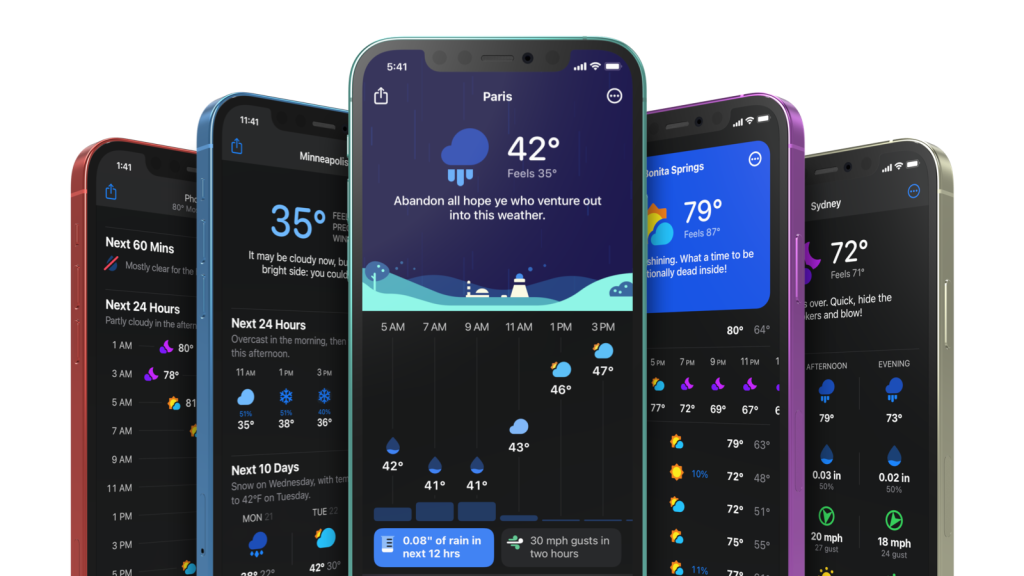
Carrot Weather: Quirky Humor Meets Robust Forecasting
Carrot Weather is well-known for its snarky personality, but beneath the humor lies a serious forecasting powerhouse. Right from the start, the interface greets you with vibrant visuals and comedic text that can be fine-tuned to your liking, ranging from family-friendly banter to dark, edgy humor.
What Makes It Stand Out
- Customization: You can tweak the AI’s sense of humor, adjust the political slant, and even pick from multiple data sources.
- Widgets and Complications: For those with an Apple Watch or iPhone lock screen widget, Carrot Weather excels in delivering concise but info-packed updates.
- Privacy: The developers emphasize they won’t sell your personal data, which has become an increasingly important factor.
Potential Downsides
- The free version is fun but limited. You’ll need to pay for detailed radar, multiple forecast sources, and advanced notifications.
- The sense of humor might not appeal to everyone, so you might toggle it off if you find it distracting.
Who Should Use It
Carrot Weather is ideal if you want a blend of entertainment and serious forecasting. It’s perfect for those who appreciate a daily chuckle while still getting highly accurate weather data from sources like Dark Sky data (now integrated into Apple Weather), AccuWeather, or other optional add-ons. If you’re an Apple Watch user, Carrot’s watch face complications are among the best in the business.
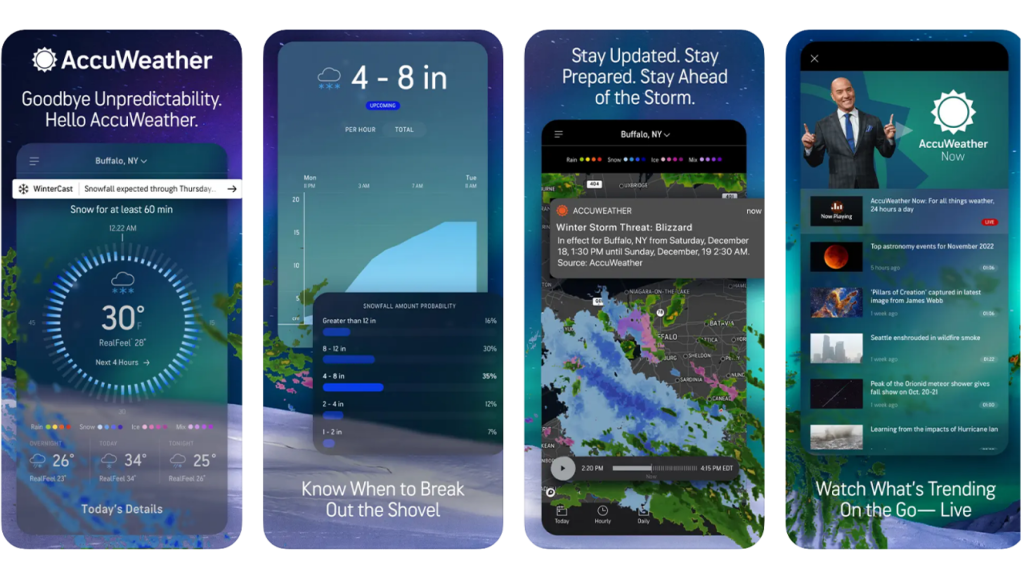
AccuWeather: Hyperlocal Forecasts and MinuteCast
AccuWeather has consistently been in the top tier of weather apps, and in 2025, it remains a strong contender for users wanting extremely detailed, localized predictions. Many appreciate the MinuteCast feature, which breaks down precipitation odds by the minute, handy if you’re planning a dog walk or an evening jog.
Notable Highlights
- MinuteCast: Tracks rain and snow on a minute-to-minute basis.
- WinterCast: Offers advanced warnings for winter storms, including snowfall probabilities.
- Global Reach: Widely respected for accurate data even outside major metropolitan areas.
Limitations
- Free version includes ads and less robust alerts. Removing ads involves a nominal monthly fee.
- Its UI, while functional, might feel a bit cluttered to minimalists.
Ideal User Profiles
Perfect for anyone who wants up-to-the-minute predictions. Outdoor enthusiasts, runners, bikers, dog walkers, will appreciate how precisely the app pins down changes in weather. Even if you live in unpredictable climates, AccuWeather’s model layering is adept at interpreting short-term and long-term shifts simultaneously.
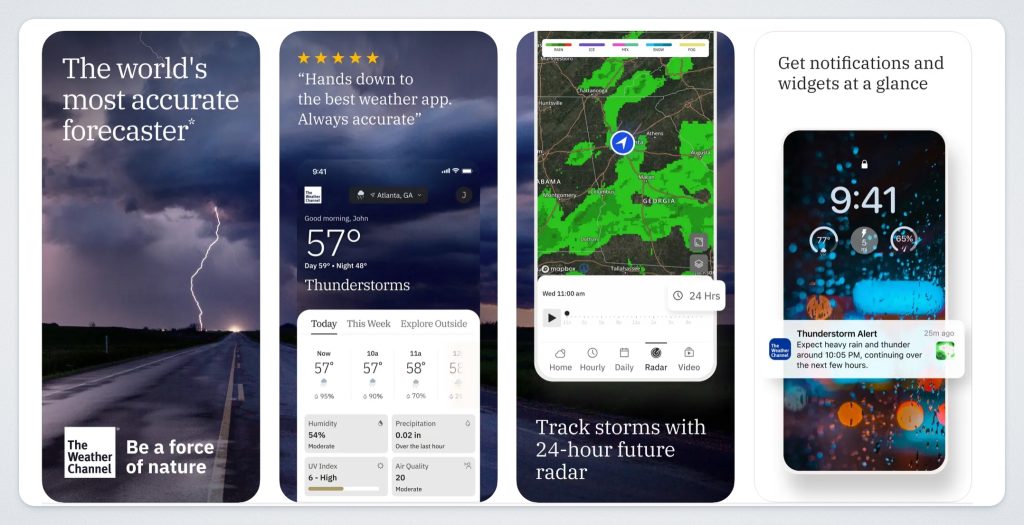
The Weather Channel: A Longtime Classic
With a legacy that spans decades, The Weather Channel app is a staple for many. It’s frequently updated to stay competitive and incorporate new features, but the main appeal remains its robust, nationally recognized meteorological authority. When you want a reliable, no-fuss forecast from a source you’ve grown up seeing on TV, The Weather Channel remains a go-to choice.
Strengths
- Ubiquity: One of the most recognized names in weather.
- Trusted Forecasts: Their meteorologists are considered top-tier professionals in the industry.
- Simple Navigation: Offers extended forecasts, hourly breakouts, and severe weather notifications.
Shortcomings
- Ads can be intrusive in the free version.
- Might lack the detailed personality or gamified approach found in apps like Carrot Weather.
Use Cases
If you prefer a straightforward, traditional weather source, this is your app. It’s also a strong all-rounder if you frequently check TV broadcasts or want an easy option to share local storm news with family and friends.

1Weather: Widget-Forward Design
1Weather is a strong contender for those who crave immediate data on their home or lock screen. Its designs are often praised for their visual clarity, featuring everything from a 10-day forecast to short-term precipitation outlooks, all easily accessible via stylish widgets.
Key Advantages
- Intuitive Widgets: Whether you prefer a minimal layout or a data-packed display, there’s a widget for you.
- Integrated Radar: Offers live radar maps, severe weather warnings, and quick toggles for precipitation details.
- Freemium Setup: The free version is sufficient for basic forecasts, with ads. The monthly subscription removes ads and unlocks advanced features.
Drawbacks
- Some users say the interface looks more “Android-inspired.” This isn’t necessarily a problem, but aesthetically, it may differ from more iOS-native designs.
- The subscription is recurring, which might not appeal to those seeking one-time purchases.
Who Benefits Most
Anyone who glances at their phone multiple times per hour and wants to see instant weather updates on the screen. If you frequently find yourself scrolling through to check the next 48-hour precipitation, 1Weather’s thorough widgets keep you in the loop.
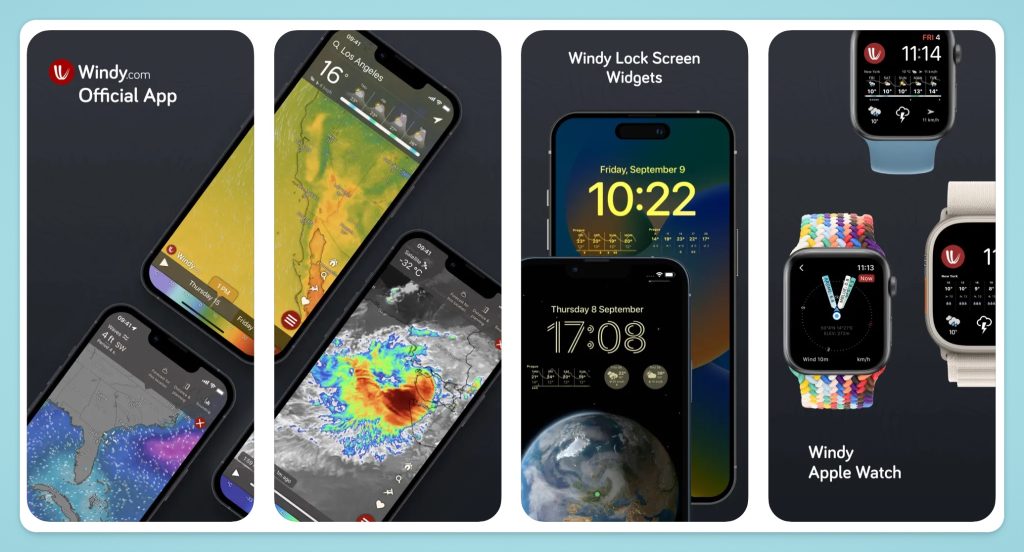
Windy: Visual Weather Mastery
Windy takes weather representation to new heights, layering multiple meteorological models over richly animated maps. You’ll see wind currents swirl in vivid color, precipitation patterns appear as shifting blues and purples, and even temperature gradients glowing like an abstract painting.
Standout Features
- Multiple Forecast Models: Switch among ECMWF, GFS, ICON, and more to compare different predictions.
- Rich Visuals: Perfect for surfers, sailors, pilots, or anyone reliant on wind intensity and direction.
- Free with Optional Subscription: Most core features are available without cost, but a subscription offers more frequent forecast updates and some additional tools.
Possible Limitations
- The abundance of map overlays might overwhelm casual users.
- Steeper learning curve if you want to interpret advanced layers like CAPE (Convective Available Potential Energy).
Who It’s For
Windy is arguably the best pick for visual learners or specialized groups like paragliders, kiteboarders, or storm watchers. Seeing multiple data layers at once makes it a go-to resource for serious planners who need a near-omniscient grasp of upcoming weather.
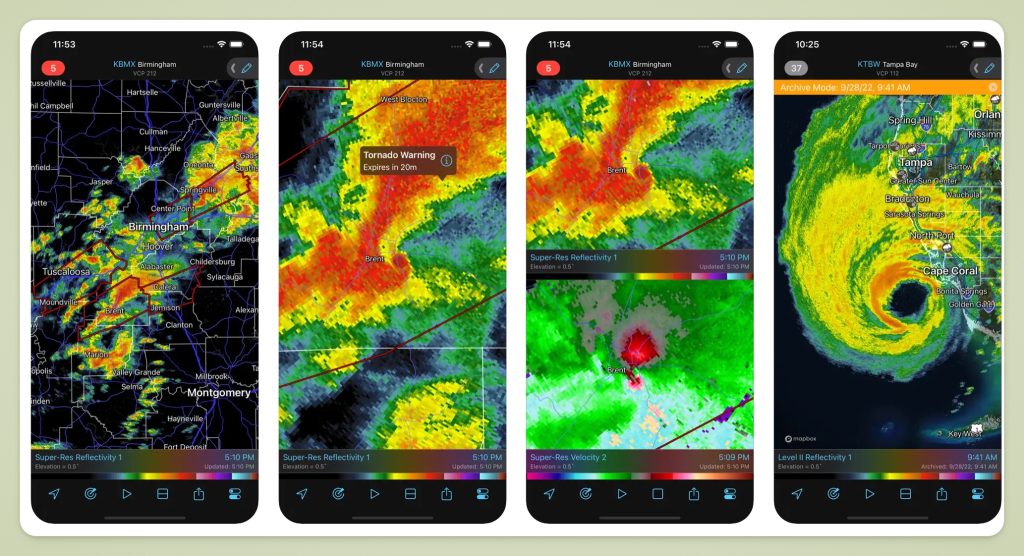
RadarScope: For the Serious Weather Enthusiast
RadarScope stands in a league of its own, appealing to meteorologists, storm chasers, or just the dedicated hobbyist who can’t get enough radar data. At its core, RadarScope provides professional-level radar rendered in original radial form, meaning the data is as close to raw output from the radar station as you can get without being a meteorologist yourself.
Core Benefits
- High-Resolution Radar: NEXRAD Level 3 data, dual-polarization, velocity scans, and more.
- Tiered Subscriptions: Base purchase unlocks robust radar scanning, with additional subscription tiers for lightning data, extended loops, and advanced scanning modes.
- Incredible Detail: Can identify storm rotation, hail cores, and other severe weather phenomena.
Potential Detriments
- Overkill for casual users. The data is more technical than a standard forecast.
- Paid model might be expensive if all you want is a general forecast.
Recommended Audience
RadarScope is for people who want advanced radar data, storm chasers, weather watchers, or anyone living in severe weather-prone regions. If you find standard radar images too basic, RadarScope’s detail might be your dream come true.
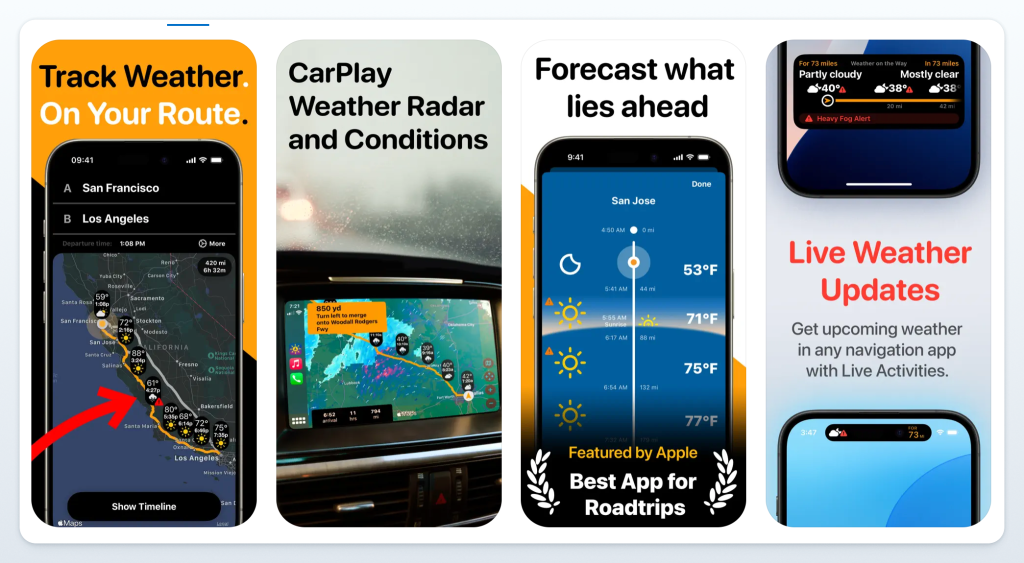
Weather on the Way: Travel-Focused Forecasting
Weather on the Way merges route planning with real-time (and predicted) weather conditions, turning a typical road trip into a safer, more informed journey. Rather than just telling you the forecast at your current location, this app calculates what you’ll face on every segment of your travel path.
Key Selling Points
- Integrated Navigation: Plots your route and overlays weather data throughout your trip.
- Safety Features: Warns of snow, rain, or severe storms along the way.
- CarPlay Support: With a Pro subscription, get road-specific forecasts right in your car’s console.
Downsides
- Geared mostly toward drivers, so it may not be as helpful if you rely on trains or flights.
- Free version is functional but lacks advanced route customizations.
Who Will Love It
Road-trippers, delivery drivers, or families planning a weekend away will appreciate how seamlessly Weather on the Way visualizes potential hazards. If you’ve ever started a lengthy drive only to run into a whiteout, this app is your solution to stress-free planning.
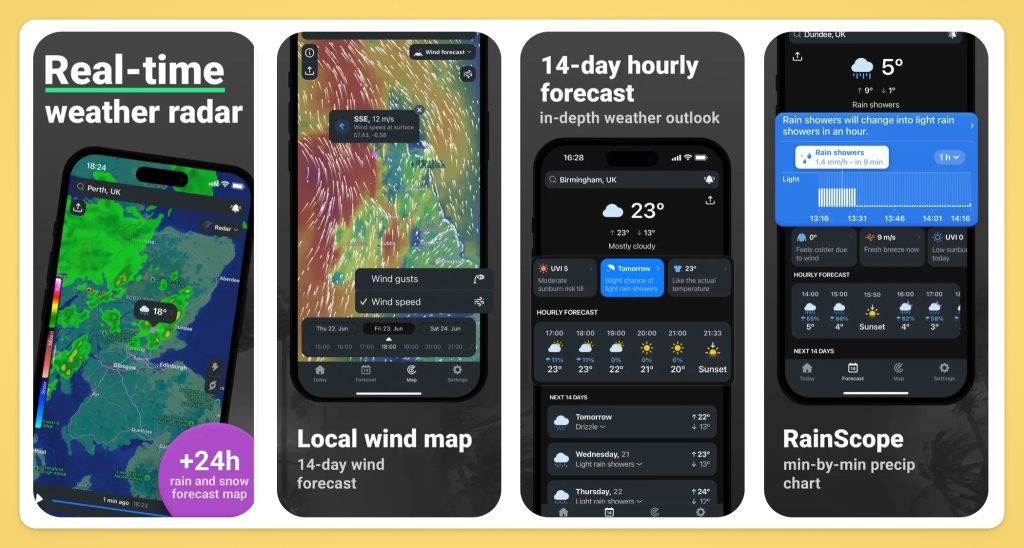
Clime (NOAA Radar Pro): Real-Time Radar Visuals
Previously known as NOAA Radar Pro, Clime centers its value on radar visualization directly sourced from NOAA (National Oceanic and Atmospheric Administration), presenting real-time data in user-friendly layers. Beyond radar, you also get typical 24-hour and 7-day forecasts, plus an array of alerts if severe weather is on the horizon.
Salient Features
- NOAA Radar Integration: Near-instant updates on developing storms.
- Lock Screen Widgets: Quickly check precipitation in your area without unlocking the phone.
- Premium Subscription: Unlocks specialized weather trackers like hurricanes, lightning, and wildfires, plus an ad-free experience.
Potential Considerations
- Clime’s strength is radar, so if you rarely check radar maps, its advanced features might be unnecessary.
- Depending on your region, NOAA’s data might be less localized than what private networks offer.
Best Fit
If your day hinges on real-time radar, maybe you’re an event organizer watching for storms or you live in a region with frequent weather shifts, Clime ensures you’re never more than a few seconds behind major developments.
Advanced Tips and Strategies for iOS Weather Apps
Owning a top-tier weather app is half the story; leveraging iOS features and fine-tuning your approach can elevate your entire experience.
Leveraging Siri and Shortcuts
Imagine waking up, grabbing your phone, and simply saying, “Hey Siri, what’s the weather for my commute?” Within seconds, you have a concise forecast, plus any severe weather warnings. Many apps integrate with Siri to deliver quick bulletins via voice command.
- Creating Shortcuts: Automate tasks like sending you a text message with the day’s forecast or turning on “Do Not Disturb” mode if severe weather is imminent.
- Location-Based Triggers: As soon as you leave your home in the morning, your phone can read out the weather for the next eight hours, ensuring you’re fully prepared.
Optimizing App Settings
Small tweaks can enhance your user experience:
- Geofenced Alerts: Enable location tracking specifically for “While Using the App” if you’re worried about battery drain.
- Notification Prioritization: Toggle on only severe alerts or real-time lightning notifications if that’s what matters most to you.
- Dark Mode vs. Light Mode: If you often check the weather at night or in a dimly lit environment, a dark interface might save battery and reduce glare.
Combining Multiple Weather Apps
Why settle for one perspective? If you often engage in activities sensitive to weather changes, running two apps side by side can be beneficial. For example, you might use Carrot Weather for daily comedic updates and general forecasts, while turning to Windy for advanced wind visuals when planning a fishing trip. By cross-referencing different models, you get a more holistic view of upcoming conditions.
Practical Use Cases
- Daily Commute: Combine a short-term forecast app like AccuWeather with a traffic app, or integrate with Siri Shortcuts to warn you of potential delays from severe weather.
- Hiking Adventures: Rely on an app with offline capabilities or reliable radar (like Clime) if you’ll be far from stable internet.
- Event Planning: Carrot Weather’s comedic forecasts can add fun to a casual get-together, while The Weather Channel’s consistent updates provide a fallback if conditions worsen.
Conclusion
In 2025, the best iOS weather apps offer nuanced experiences tailored to just about any need, from humor-infused daily predictions to hyperlocal, science-driven forecasts and specialized radar data. Choosing the ideal one boils down to understanding your routine and deciding which features you can’t live without. For a fusion of entertainment and precise meteorological insight, Carrot Weather is a top contender. AccuWeather is the go-to for minute-level accuracy, while RadarScope appeals to the genuinely weather-obsessed. If travel is your primary concern, Weather on the Way is the clear choice. And for those who thrive on mesmerizing visuals and multiple forecast models, Windy stands out for its mesmerizing approach.
Which weather app is most accurate for international travelers?
AccuWeather is often praised for its global reach, offering hyperlocal forecasts even when you’re abroad. Windy also provides multiple forecast models that cover most regions worldwide, letting you compare data from different sources for the best accuracy.
How do I reduce battery usage while using weather apps on my iPhone?
Set location permissions to “While Using the App” or “Only When Active” rather than always-on tracking. Disable excessive push notifications and background refresh for apps you don’t open frequently. Apps like Carrot Weather also let you control how often the forecast updates in the background to conserve battery.
Are free versions of these apps sufficient for severe weather alerts?
Many apps provide basic severe weather notifications in their free versions. However, advanced or specialized alerts (like lightning strike proximity or extended radar loops) are often behind a subscription. The Weather Channel, for example, includes standard alerts for free, while RadarScope locks more in-depth radar scans behind a paid tier.
What makes specialized apps different from Apple’s default Weather app?
Apple’s native app has improved significantly, but specialized apps often offer multi-model data, deeper radar insights, and niche features like road trip planning or comedic commentary. If you require advanced features such as maritime weather detail or geostationary radar loops, a dedicated third-party app is usually more robust.
Can I use multiple apps to create my own custom forecast system?
Absolutely. Many power users rely on one app for daily forecast and notifications (e.g., AccuWeather or Carrot Weather) and use another (like Windy or RadarScope) for in-depth analysis. By cross-referencing data, you get a more comprehensive picture of impending weather events.
Experiment with free trials and different subscription models to find the one that aligns with your life. After all, weather affects everything, from your morning jog to the success of that weekend barbecue. By equipping yourself with the right digital tools, you’ll never get caught unprepared by a sudden storm or an unexpected heatwave again.
